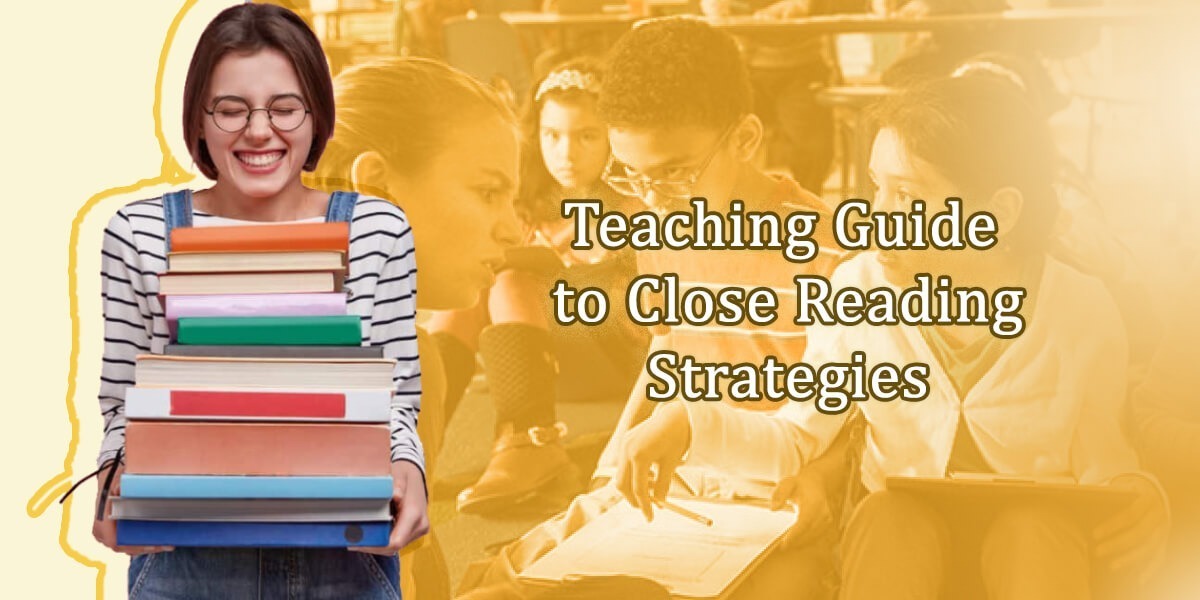The Close Reading strategies are being utilized by several educational systems around the world. That is because it is one of the most effective strategies to help students learn how to read. Students follow a process of learning how to read by understanding and analyzing small passages of written text.
If you also want to use this strategy to help your students learn more effectively, this guide blog is going to be helpful for you. That is because we are going to provide you with a complete comprehensive step-by-step guide on how you can apply this strategy. So, let’s get started.
What are Close Reading Strategies?
Close reading involves active engagement with a text through repeated examination. It differs from casual reading by requiring students to deeply interrogate a work through questioning, note-taking, and discussion. The purpose is to uncover implicit ideas, understand layers of significance and analyze craft elements like word choice and structure. This deep dive allows students to synthesize an author’s message and perspective.
Close Reading Strategies also cultivate higher-order thinking. Students must make inferences, recognize patterns and determine how specific details support overarching themes. It develops transferable analytical skills across disciplines like literature, history, and science. Overall, close reading helps students truly comprehend what they read beyond a surface level.
Choosing an Appropriate Text
Selecting suitable material is pivotal for a fruitful Close Reading Strategies lesson. When choosing a text, consider the following factors – length, complexity, student interest and topic familiarity. An ideal immediate reading passage is 200-400 words, allowing careful examination within one class. Text complexity relies more on conceptual difficulty than word count or grade level.
Gauge your class’s background knowledge and choose a topic engaging enough to sustain focus. Multiple short texts can work, too, by allowing comparison. Authentic literature, primary sources, newspaper articles, and short stories often make good close-reading readers. Evaluate if vocabulary and concepts are accessible but still challenging through critical thought.
Sample texts that would facilitate an introductory close reading are an op-ed on climate change, a historical speech, short fiction about overcoming adversity or a science journal excerpt. Becoming adept at text selection helps craft targeted close reading lessons.
Pre-Reading Activities
The pre-reading stage primes students’ minds for delicate analysis. Activate prior knowledge by discussing the topic and asking questions to gauge familiarity. Having students make predictions about the text based on its title and visual elements gets them thinking beyond the surface level.
Another strategy is “vocabulary in context” – students skim to underline unfamiliar words and attempt to define them based on surrounding clues rather than checking dictionaries. This previews new vocabulary in a meaningful way. Post-reading, revisiting predictions, and modified vocabulary definitions show comprehension growth.
General open-ended pre-reading questions encourage critical thought. Examples include – What do you already know about this topic? What questions do you have? What elements might the author discuss? How could this text change your ideas?
The Initial Reading
During the initial reading, the goal is general comprehension rather than close analysis. Instruct students to read steadily to gain a broad understanding of people, events, main ideas and sequence.
To check basic comprehension, ask simple factual questions: What is the title? When does this take place? Who are the critical characters introduced? What is the general topic or conflict so far? Having students briefly discuss answers reinforces understanding.
Emphasize that annotations or note-taking are unnecessary for the initial read. Its purpose is to grasp the overall narrative or informational structure, not yet scrutinize wording or craft elements. Having enjoyed the read, coming to class primes an open mindset for close examination.
Close Annotation
Annotation is integral to Close Reading Strategies, allowing students to engage with the text actively through written responses. Teach clear annotation symbols and their purpose – circling unfamiliar vocabulary, underlining significant quotes, noting questions/connections/predictions with a ?! or *.
Model annotation by thinking aloud about your thought process while annotating a short text selection. Ask students to annotate independently and compare approaches. Provide an annotation checklist to guide thorough engagement – number of annotations, variety of symbols used, quotes underlined, etc.
Explain that annotations should delve below surface-level details. For example, circling “evaporation” and noting “How does this relate to the water cycle?” Sample annotated texts demonstrate how notes can reveal more profound implicit ideas and craft elements for discussion. With practice, annotation becomes an intuitive reading habit.
Pausing for Discussion
Pausing after paragraphs or logical breaks allows students to share insights, ask peers for help comprehending complex parts and work through the text together. Come prepared with open-ended questions like – What observations or questions do you have so far? What confuses or interests you the most?
Higher-order questions beginning with how or why probe more deeply: How does the author’s word choice impact you? Why might they have structured this paragraph in this way? Calling on various students encourages participation. Affirm and build on responses to cultivate analysis.
Emphasize there are no “wrong” answers during the discussion – the goal is a thoughtful exchange of perspectives to advance understanding. Having students briefly write responses also holds them accountable and assesses comprehension in a low-stakes way. Maintaining a comfortable environment is critical for insightful conversations.
Rereading and Analysis
Once students gain initial comprehension, subsequent reads allow focus on craft elements and synthesizing annotations. Instruct to reread with notes, underlining any other insights. Questions for analysis may include:
- How does vocabulary contribute to the author’s message/tone?
- What patterns emerge in word choice or descriptions?
- How does the sequence/structure impact the narrative/arguments?
- What can be inferred about the author’s perspective or purpose?
Direct attention to textual layers beyond surface events. I was asking “why” probes deeper into significance and themes. Continual discussion reinforces skills for independent analysis of increasingly complex texts.
Read More: Strategies for Teaching Multicultural Education in the Classroom
Synthesis and Reflection
Having students internalize their learning through summarization and reflection helps cement comprehension and critical thinking abilities. Ask a culminating open-ended question for small groups to discuss and answer, such as:
- How do the author’s craft elements support their overall message?
- What new understandings have you gained from this text?
- How might this information be useful in (another subject area)?
A full-class discussion allows sharing of varied perspectives. In addition, having students individually write a 1-paragraph reflection assessing their close reading skills provides metacognition. Sample prompts include progress made, most/least valuable strategies and goals for future reads. Review improves independent analysis.
Scaffolding Independence
Gradually reducing support leads to independent critical reading ability. Begin by having students closely read in small groups with guidance, then working in pairs, consulting only when stuck. Provide tools like annotation checklists, discussion prompts, modelling texts and peer feedback to guide independent practice.
Assign short sections for homework analysis using learned strategies. Upon returning, have students exchange insights in “jigsaw” groups requiring no preparation. This scaffolds the application of skills to new texts.
Ongoing independent practice across subjects with teacher check-ins allows Close Reading Strategies to generalize as a habit. Sample resources include online discussion forums, literature circles, Socratic seminars and reading response journals. Independence cultivates lifelong analytical skills.
Formative Assessment
Formative assessment informs instruction and ensures skills are mastered. Observing students annotate, ask questions and discuss texts gauges engagement and comprehension. Quick writes after readings assess understanding concisely. Reading journals maintained over time illustrates growth.
Conclusion
In conclusion, teaching Close Reading Strategies systematically through a scaffolded process equips students with critical skills. When integrated across disciplines, close reading empowers independent comprehension of diverse texts. It cultivates abilities to interpret deeper meanings, recognize craft elements and think critically. Ongoing practice and formative assessment reinforce each step. With adaptation based on student needs, this guide outlines a practical framework for instructing close reading techniques to advance literacy.







